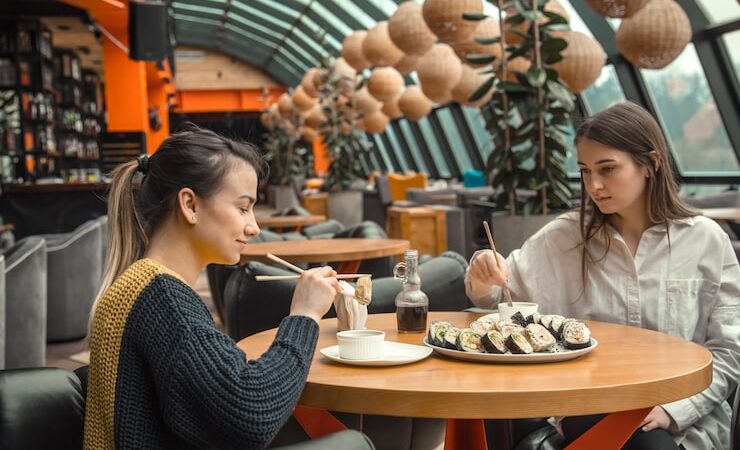Introduction
Food is key in each food spot, yet not in all. The look and feel of the room play a huge role. We call this part restaurant décor. It is the way walls, lights seats, and sound blend. It shapes mood, taste, and trust for all who walk in.
A rich dish can lose charm in a poor space. A fair dish can shine in a warm and neat space. This is why décor is a strong base for food spots. In this piece, we will see how décor shapes guest picks.

The Power of First Sight
The first sight of the place shapes the guest’s view. A warm and neat space makes them feel calm. A dull and poor space makes them feel lost. First sight is a key part of the guest’s mood. Bright walls, neat seats, and soft light build trust.
Dirty, dark walls or poor seats harm mood fast. This first mark is hard to change once set. Good spots know this and plan décor with care. A good first sight is the start of a fine meal.
How Color Shapes Mood
Color is a key tool in the art of décor. Warm shades like red and gold spark joy and cheer. Cool shades like blue or green bring calm and rest. Bright tones give life, while dull tones harm the mood.
Food looks richer with the right shades of light. Guests also link tones with taste in the mind. Red may boost food cravings while blue may calm them. This shows that tone choice is more than just style. It is a tool to shape mood, taste, and choice.
The Role of Light
Light is a strong part of the décor in each spot. Soft light gives a calm and warm feel to guests. Bright light adds life and makes the space glow. Poor light harms the food’s look and guests’ joy quickly. Good spots use both soft and bright light with skill.
They place light to show food in the best way. They also use it to shape the mood in the room. Warm lamps bring a homey feel, while cool light feels sharp. Light is not just for sight, it is for feel. It is one of the true marks of fine restaurant décor.
How Space Affects Guest Mood
The space plan is one of the key parts of the décor. A wide plan makes guests feel free and at ease. A tight plan makes them feel stuck and tense. Good décor keeps walkways neat and seats well set. Each guest needs a fair room to move, sit, and rest.
Poor space plan harms mood and slows service flow. Good plan lifts joy and helps staff serve with ease. The way space is laid out shapes guest trust. It shows if the spot cares for both guests and staff.
The Link of Décor and Food
Food and décor are not two parts they are one. A rich dish can fail if the room feels poor. A fair dish can taste rich in a fine space. The blend of food and décor makes the full meal. Mood plays a role in how food feels on the tongue.
When décor lifts mood, food feels fresher and richer. This blend is why guests come back to the same spot. They come not just for food but for the feel too. Décor and food work hand in hand to shape joy.
Why Décor Builds Guest Trust
Trust is key for a food spot to grow strong. Guests judge the place first by what they see. Neat décor shows care and respect for each guest. Poor décor makes them doubt the food and staff as well. Trust comes from the look as much as the taste.
When a guest feels safe, they plan to come back. They also share kind words with kin and mates. Good décor is not just style, it is a sign of trust. This trust builds bonds and long term fame for the spot.
The Role of Music in Décor
Décor is not just what we see, it is what we hear. Music shapes mood as much as light or tone. Soft tunes bring calm while loud beats spark life. The right sound mix makes food taste richer. Poor sound harms joy and makes guests feel tense.
Good spots pick tunes that match food and time. Light tunes for lunch and soft beats for the night. This shows how sound is a part of décor. It is a tool to shape the mood and guests’ picks.

How Seasonal Décor Shapes Mood
Décor that shifts with time adds charm to the spot. Warm lights in cold weather bring more joy. Cool shades in hot weather bring calm and rest. Fest look in feast time makes guests feel at home.
A spot that adapts décor shows care for each guest. This small act makes them feel linked to the place. It also brings them back to see the new décor each time. Seasonal décor is a way to blend mood with time. It keeps the place fresh and full of new charm.
Why Décor Adds to Brand Name
Décor is not just for mood, it builds the brand. Each spot has a style that sets it apart. A bold wall, a soft lamp, or a neat seat can be a mark. Guests recall décor as much as they recall food.
A strong décor style helps the spot stand out. It makes the place easy to name and share. This adds to long term fame and guest bond. Décor is a brand tool that tells the tale of the spot.
Conclusion
Food is the base, yet décor is the frame. The way walls, lights tones, and sound blend shape the mood. A neat dish may fail in a poor space. A fair dish may shine in a warm, neat space. This shows how deep décor is in food spots.
It builds mood, trust taste, and guest bond. It draws guests back and helps build a strong name. Poor décor harms trust and breaks the full guest joy. This is why restaurant décor is not just style. It is a true art and the soul of each spot.
